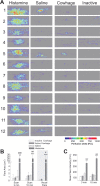Psychophysical and physiological evidence for parallel afferent pathways mediating the sensation of itch
- PMID: 17626210
- PMCID: PMC6672596
- DOI: 10.1523/JNEUROSCI.1249-07.2007
Psychophysical and physiological evidence for parallel afferent pathways mediating the sensation of itch
Abstract
The neuronal pathways for itch have been characterized mainly based on responses to histamine. Intracutaneous application of histamine produces intense itch and a large area of axon-reflexive vasodilation ("flare") around the application site. Both phenomena are thought to be mediated through neuronal activity in itch-specific, mechanoinsensitive C-fiber afferents (CMi). However, mechanical and electrical stimuli that do not activate CMi fibers can cause the sensation of itch, and itch may occur without flare, suggesting that other neuronal itch pathways exist. Because cutaneous application of spicules from the plant Mucuna pruriens (cowhage) has been anecdotally reported to produce itch without flare, we performed psychophysical experiments to investigate whether the mechanisms underlying cowhage- and histamine-induced itch differ. Although histamine and cowhage produced itch of similar magnitude, the itch to cowhage was not correlated with the itch to histamine; some subjects had intense itch to cowhage and little itch to histamine and visa versa. Laser Doppler measurements of blood flow revealed that histamine led to a large area of vasodilation, whereas cowhage produced vasodilation restricted to the application site. Pretreatment of the skin with an antihistamine blocked the itch produced by histamine but did not prevent cowhage-induced itch. Desensitization of the skin with topical capsaicin abolished cowhage-induced itch but did not significantly alter histamine-induced itch. These findings indicate that cowhage itch is signaled through a population of capsaicin-sensitive afferent nerve fibers that is distinct from CMi fibers mediating histamine-induced itch. Cowhage may be useful to investigate the neural pathway mediating nonhistaminergic itch.
Figures






References
-
- Andrew D, Craig AD. Spinothalamic lamina I neurons selectively sensitive to histamine: a central neural pathway for itch. Nat Neurosci. 2001;4:72–77. - PubMed
-
- Bernstein JE, Whitney DH, Soltani K. Inhibition of histamine-induced pruritus by topical tricyclic antidepressants. J Am Acad Dermatol. 1981;5:582–585. - PubMed
-
- Darsow U, Ring J, Scharein E, Bromm B. Correlations between histamine-induced wheal, flare and itch. Arch Dermatol Res. 1996;288:436–441. - PubMed
-
- Davidson S, Zhang X, Khasabov SG, Simone DA, Giesler GJ. Characterization of pruriceptive spinothalamic tract neurons in the monkey. Soc Neurosci Abstr. 2005;31:171–20.
Publication types
MeSH terms
Substances
Grants and funding
LinkOut - more resources
Full Text Sources
Medical
Research Materials
Miscellaneous
